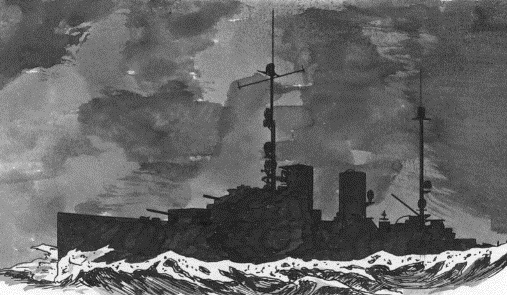Hr. Ms. Java
Hr. Ms. Sumatra in 1939
Vickers design for Dutch battleship anno 1913
The minister himself (3) stated that for the Dutch East Indies battleships (4) were needed, certainly not battle cruisers. The major naval powers also built no more battle cruisers. On the other hand were light cruisers needed. And the cruisers to be built for the Royal Netherland Navy were such heavy armed and fast as no other navy possessed.
Notes
1. Hendrik (Henri) Pieter Staal (17 June 1845 Zwolle, Netherlands-15 October 1920 The Hague, Netherlands), liberal politican, ended his military career in the rank of lieutenant general, member of the First Chamber 10 May 1906-15 October 1920 especially for colonial and military affairs and minister of war 17 August 1905-7 April 1907.
2. The light cruisers Hr. Ms. Java and Sumatra and the somewhat larger Celebes, built using a German Krupp Germaniawerft design. Due to the outbreak of the First World War, shortage of materials, lacking sufficient budget, strikes were the first two ships completed after the war. Due to war experiences was the first modern design now just an obsolete one. The Celebes was even not completed. With a displacement of 6,670 tons were her dimensions 155,30 x 16,00 x 5,50 metres. The two turbines and eight boilers driven 3 screws supplied 72,000 ahp allowing a speed of 31 miles. The armour consisted of a 25-50mm deck, a 75mm belt while the conning tower was protected by 100-125mm. The armament consisted of 10-15cm guns, 4-40mm machineguns, 6-12,7mm machine guns and 2 rails for each 5 depth charges. Her crew numbered 525 men.
Hr.Ms. Java. Laid down at the Koninklijke Maatschappij De Schelde at Flushing, Netherlands on 31 May 1916, launched on 9 August 1921 and lost on 27 February 1942 during the battle in the Java Sea. Due to lacking material caused by the First World War and enough budget was her launching and completion delayed. After the approval of the budget for 1919 was the building of the Java and her sister ship Sumatra continued. During the trials in June-July 1924 suffered she from fire. Despite the damage were the trials very successful and afterwards was she finally repaired. Commissioned on 1 May 1925.
Hr. Ms. Sumatra. Laid down at the yard of the Nederlandsche Scheepsbouw Maatschappij at Amsterdam on 15 July 1916, launched 19 December 1920, scuttled as a block ship off Quistreham, France as part of an artificial harbour which was never realized. The wreck was sold in February 1951 to Persia [Iran] to be broken up. -125mm. The armament consisted of 10-15cm guns, 4-40mm machineguns, 6-12,7mm machine guns and 2 rails for each 5 depth charges. Her crew numbered 525 men.
3. Jean Jacques Rambonnet (8 March 1864 Wijhe, Netherlands-3 August 1943 Rotterdam, Netherlands), liberal politician, minister of navy 29 August 1913-28 June 1918. Ended his military career in the rank of vice-admiral in 1922.
4 From German, Italian and British shipyards were tenders received, but due to the outbreak of the First World War were none battleships ever realized or even started.



